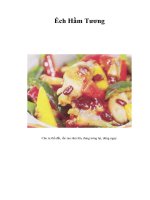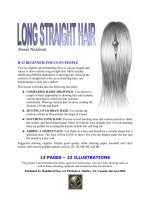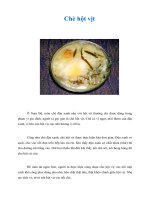Tài liệu Playing With Pencils docx
Bạn đang xem bản rút gọn của tài liệu. Xem và tải ngay bản đầy đủ của tài liệu tại đây (1.39 MB, 14 trang )
Brenda Hoddinott
F-03 BEGINNER: HATCHING
Many artists struggle unnecessarily for years to create a full range of values with only one or two
pencils, totally unaware of how pencils themselves can create different values. In this lesson, you
create the illusion of depth in a mountain range, by using various grades of pencils. You will also
utilize two components of perspective, overlapping and atmospheric perspective.
This lesson is divided into the following three parts:
INTRODUCTION: When you use a combination of several H and B pencils you can easily
create a full range of values in your drawings.
SKETCHING ELEVEN MOUNTAINS: You sketch eleven overlapping mountains,
beginning with the one that appears closest, and working back toward the distant mountain
and the sky.
PENCILS BUILD A MOUNTAIN RANGE: You use 12 different grades of pencils to add
shading to each section of the sky and mountain range to render the illusion of depth as
created by atmospheric perspective.
Suggested supplies include white drawing paper, kneaded and vinyl erasers, a pencil sharpener,
and 5H, 4H, 3H, 2H, HB, 2B, 3B, 4B, 5B, 6B, 7B and 8B pencils.
This project is recommended for artists and aspiring artists of all ages, as well as
home schooling, academic and recreational fine art educators.
14 PAGES – 27 ILLUSTRATIONS
Published by Hoddinott Fine Art Publishers, Halifax, NS, Canada, 2005 (Revised 2006)
Copyright to all articles, images, text, projects, lessons and exercises within this drawing class belong to Brenda Hoddinott and may
not be reproduced or used for any commercial purposes whatsoever without the written permission of Brenda Hoddinott.
Web sites and
2
INTRODUCTION
Many artists labor unnecessarily for years to create a full range of values with only one or two
pencils, totally unaware of how pencils themselves can create different values. Generally
speaking, H pencils work beautifully for light and middle values, and B pencils are best for
middle and dark values. When you use a combination of several H and B pencils you can easily
create a full range of values in your drawings.
Refer to the following two illustrations to get an idea of the goal of this lesson. Various grades of
pencils help create the illusion of depth in the mountain range.
ILLUSTRATION 03-01
First of all, you will sketch a
range of eleven mountains.
You will then add shading to
each mountain with a different
grade of pencil. You need 5H,
4H, 3H, 2H, HB, 2B, 3B, 4B, 5B,
6B, 7B and 8B pencils. 2H is the
lightest (hardest), and the 8B is
the darkest (softest).
ILLUSTRATION 03-02
In addition to using various
grades of pencils, you will
employ two components of
perspective, overlapping and
atmospheric perspective.
Overlapping is a technique that
gives the illusion of depth in a
drawing, and refers to the
position of subjects in a
composition, when one visually
appears to be in front of another
(or others).
Atmospheric perspective (sometimes called aerial perspective) refers to the visual depth created
by various particles in the atmosphere. The farther an object recedes into the distance, the lighter
in value it seems to become, and its edges and forms appear more blurred.
To learn more about the fundamentals of perspective, refer to lesson
E-01 Basic Perspective for Beginners.
Copyright to all articles, images, text, projects, lessons and exercises within this drawing class belong to Brenda Hoddinott and may
not be reproduced or used for any commercial purposes whatsoever without the written permission of Brenda Hoddinott.
Web sites and
3
SKETCHING ELEVEN MOUNTAINS
In this section, you sketch eleven overlapping mountains beginning with the one that is closest
and working back toward the distant mountain and the sky. When sketching overlapping objects,
I generally find it easier to draw those in the foreground first.
1. Outline a horizontal rectangle, similar in shape to mine, as your drawing space.
A drawing space (also called the drawing surface or drawing format) is the area in which
you render a drawing within a specific perimeter. A horizontal rectangle is often referred to
as a landscape format. You can either turn your drawing paper horizontally, or you can use a
ruler to draw a rectangle as your drawing space. My drawing space is 3 by 5 inches.
As you continue through this section, try to draw the outlines of the mountains in
approximately the same locations as in my sketches.
ILLUSTRATION 03-03
2. Sketch the outline of
a mountain in the
lower left corner of
the drawing space.
Use a 2H pencil and
press very lightly so
you don’t indent the
paper.
ILLUSTRATION 03-04
3. Outline a second
mountain behind the
first.
While it’s important
to draw your
mountains in
approximately the
same locations as
mine, there’s no need
to make their shapes
exactly like mine.
Feel free to draw
them more rounded or
jagged.
Copyright to all articles, images, text, projects, lessons and exercises within this drawing class belong to Brenda Hoddinott and may
not be reproduced or used for any commercial purposes whatsoever without the written permission of Brenda Hoddinott.
Web sites and
4
ILLUSTRATION 03-05
4. Sketch the
remaining nine
mountains.
Follow along with
the following nine
sketches
(Illustrations 03-05
to 13).
ILLUSTRATION 03-06
ILLUSTRATION 03-07
Copyright to all articles, images, text, projects, lessons and exercises within this drawing class belong to Brenda Hoddinott and may
not be reproduced or used for any commercial purposes whatsoever without the written permission of Brenda Hoddinott.
Web sites and
5
ILLUSTRATION 03-08
ILLUSTRATION 03-09
ILLUSTRATION 03-10
ILLUSTRATION 03-06
Copyright to all articles, images, text, projects, lessons and exercises within this drawing class belong to Brenda Hoddinott and may
not be reproduced or used for any commercial purposes whatsoever without the written permission of Brenda Hoddinott.
Web sites and
6
ILLUSTRATION 03-11
ILLUSTRATION 03-12
ILLUSTRATION 03-13
Copyright to all articles, images, text, projects, lessons and exercises within this drawing class belong to Brenda Hoddinott and may
not be reproduced or used for any commercial purposes whatsoever without the written permission of Brenda Hoddinott.
Web sites and
7
ILLUSTRATION 03-14
5. Neatly outline each
mountain with the
pencil that will be
used for its shading.
For example, the
first one you drew
in the lower left of
the drawing space
needs to be outlined
with an 8B pencil,
the one directly
behind it with a 7B,
and so on.
PENCILS BUILD A MOUNTAIN RANGE
Artists have been drawing with graphite for centuries and even today it remains the most popular
drawing medium. It has withstood the test of time for permanence, and lends itself beautifully to
all styles of drawing.
In this section, you add shading to each section of the mountain range to render the illusion of
depth as a result of various particles in the atmosphere. Shading is the process of adding values
to a drawing so as to create the illusion of form and/or three-dimensional spaces. Feel free to use
whatever style of shading you prefer, such as hatching or squirkling (I’ve used hatching).
ILLUSTRATION 03-15
6. Use an 8B
pencil to
add a very
dark
value to
the closest
mountain,
in the
lower left
corner.
Copyright to all articles, images, text, projects, lessons and exercises within this drawing class belong to Brenda Hoddinott and may
not be reproduced or used for any commercial purposes whatsoever without the written permission of Brenda Hoddinott.
Web sites and
8
7. Continue shading each mountain in sequence from the foreground to distant space.
Use the pencils indicated in Illustration 03-14.
ILLUSTRATION 03-16
Use a 7B for this mountain
ILLUSTRATION 03-17
Use a 6B for this mountain
Copyright to all articles, images, text, projects, lessons and exercises within this drawing class belong to Brenda Hoddinott and may
not be reproduced or used for any commercial purposes whatsoever without the written permission of Brenda Hoddinott.
Web sites and
9
Each mountain needs to be shaded a little lighter than the last. Hence, you may need to
occasionally go back over some mountains and adjust their values a little. To make a mountain
darker you need to press a little harder with your pencil, and to make the value lighter, you ease
off on the pressure used. If a mountain seems way too dark, you can pat it with your kneaded
eraser and redo the shading until you are happy with the results.
ILLUSTRATION 03-18
Use a 5B for this mountain
ILLUSTRATION 03-19
Use a 4B for this mountain
Copyright to all articles, images, text, projects, lessons and exercises within this drawing class belong to Brenda Hoddinott and may
not be reproduced or used for any commercial purposes whatsoever without the written permission of Brenda Hoddinott.
Web sites and
10
ILLUSTRATION 03-20
Use a 3B for this mountain
ILLUSTRATION 03-13
ILLUSTRATION 03-21
Use a 2B for this mountain
Copyright to all articles, images, text, projects, lessons and exercises within this drawing class belong to Brenda Hoddinott and may
not be reproduced or used for any commercial purposes whatsoever without the written permission of Brenda Hoddinott.
Web sites and
11
ILLUSTRATION 03-22
Use a HB for this mountain
ILLUSTRATION 03-23
Use a 2H for this mountain
Copyright to all articles, images, text, projects, lessons and exercises within this drawing class belong to Brenda Hoddinott and may
not be reproduced or used for any commercial purposes whatsoever without the written permission of Brenda Hoddinott.
Web sites and
12
ILLUSTRATION 03-24
Use a 3H for this mountain
ILLUSTRATION 03-25
Use a 4H for this mountain
Copyright to all articles, images, text, projects, lessons and exercises within this drawing class belong to Brenda Hoddinott and may
not be reproduced or used for any commercial purposes whatsoever without the written permission of Brenda Hoddinott.
Web sites and
13
ILLUSTRATION 03-26
Use a 5H to add shading to the sky
As a final touch, (if you want your drawing to look really neat), you can outline the edges of
each mountain again with freshly sharpened pencils (as you did in step 6).
ILLUSTRATION 03-27
Copyright to all articles, images, text, projects, lessons and exercises within this drawing class belong to Brenda Hoddinott and may
not be reproduced or used for any commercial purposes whatsoever without the written permission of Brenda Hoddinott.
Web sites and
14
BRENDA HODDINOTT - BIOGRAPHY
As a self-educated teacher, visual artist, portraitist, forensic artist, and illustrator, Brenda
Hoddinott utilizes diverse art media including graphite, technical pen, colored pencil, chalk
pastel, charcoal, conté crayon, and oil paints.
My philosophy on teaching art is to focus primarily on the
enjoyment aspects while gently introducing the technical and
academic. Hence, in creating a passion for the subject matter,
the quest for knowledge also becomes enjoyable.
>Brenda Hoddinott<
Born in St. John’s, Newfoundland, Brenda grew up in the small town of Corner Brook. She
developed strong technical competencies with a personal commitment to self directed learning,
and the aid of assorted “Learn to Draw” books. During Brenda’s twenty-five year career as a
self-educated civilian forensic artist, numerous criminal investigation departments have
employed Brenda’s skills, including Royal Canadian Mounted Police and municipal police
departments. In 1992, Brenda was honored with a commendation from the Royal Canadian
Mounted Police, and in 1994, she was awarded a Certificate of Membership from “Forensic
Artists International”.
Her home-based art career included graphic design, and teaching recreational drawing and
painting classes. As supervisor of her community’s recreational art department, Brenda hired and
trained teachers, and designed curriculum for several children’s art programs. In 1998, Brenda
chose to end her eighteen-year career as an art educator in order to devote more time to writing,
drawing, painting, and developing her websites.
Drawspace
incorporates her unique style and innovative approach to
curriculum development. This site offers downloadable and printable drawing classes for
students of all abilities from the age of eight through adult. Students of all ages, levels and
abilities have praised the simple step-by-step instructional approach. This site is respected as a
resource for fine art educators, home schooling programs, and educational facilities throughout
the world.
LEARN-TO-DRAW BOOKS BY BRENDA HODDINOTT
Drawing for Dummies (2003): Wiley Publishing, Inc., New, York, NY, this 336 page book
is available on various websites and in major bookstores internationally.
The Complete Idiot’s Guide to Drawing People (2004): Winner of the Alpha-Penguin
Book of the Year Award 2004, Alpha - Pearson Education – Macmillan, Indianapolis, IN,
this 360 page book is available on various websites and in major bookstores internationally.









